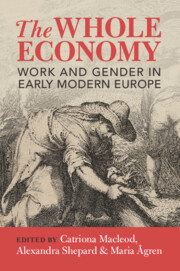2 - Care
Published online by Cambridge University Press: 09 June 2023
Summary
Care work is both a pre-condition for economic activity and a form of economic activity in its own right. Its extent, character and distribution has varied from place to place and over time in ways which suggest it is erroneous to assume that care was either a constant or somehow external to the economy. Indeed, rather than presuming that, historically, women’s work was determined by and shaped around the care burden, there is a good deal of evidence to suggest that the organization of care in early modern Europe was designed to enable women’s (as well as men’s) productive work. This chapter explores the variation in the extent and character of the care burden and the complex distribution of care between familial, commercial, voluntary and state-sponsored domains. Such variation and complexity suggest that women’s – and men’s – contribution of unpaid care work was anything but constant. The burgeoning market for paid care services in early modern Europe allows assessment of the monetary value of unpaid care and the ways in which the allocation of care was part of family strategies to maximize married women’s productive work. Care, therefore, is a necessary variable for the assessment of early modern economic performance.
Keywords
- Type
- Chapter
- Information
- The Whole EconomyWork and Gender in Early Modern Europe, pp. 53 - 83Publisher: Cambridge University PressPrint publication year: 2023
- 1
- Cited by

